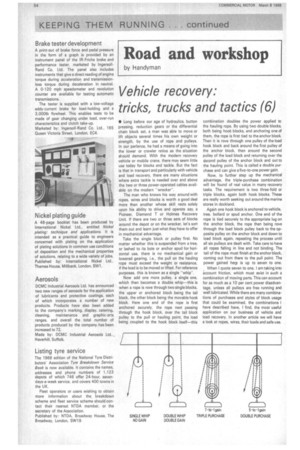Vehicle recovery: tricks, trucks and tactics (6)
Page 56

If you've noticed an error in this article please click here to report it so we can fix it.
• Long before our age of hydraulics, button pressing, reduction gears or the differential chain block set, a man was able to move or lift objects several times his own weight or strength, by the use of rope and pulleys. In our parlance, he had a means of going into the lower or crawler ratios as the situation should demand. With the modern recovery vehicle or mobile crane, there may seem little use today for blocks and tackle. But the fact is that in transport and particularly with vehicle and load recovery, there are many situations where extra tackle is needed over and above the two or three power-operated cables available on the modern "wrecker".
The man who knows his way around with ropes, wires and blocks is worth a good deal more than another whose skill. rests solely upon his ability to drive and operate say, a Pioneer, Diamond T or Holmes Recovery Unit. If there are two or three sets of blocks around the depot or on the wrecker, let's sort them out and learn just what they have to offer in mechanical advantage.
Take the single block or pulley first. No matter whether this is suspended from a tree, or lashed to its bole or anchor spud for horizontal use, there is no mechanical gain or lowered gearing, i.e., the pull on the hauling rope must exceed the weight or resistance, if the load is to be moved or lifted. For reference purposes, this is known as a single "whip".
Now add one more pulley, a single one, which then becomes a double whip—this is when a rope is rove through two single blocks, the upper or anchored block being the tail block, the other block being the movable hook block. Here one end of the rope is first anchored securely, the rope next passing through the hook block, over the tail block pulley to the pull or hauling point, the load being coupled to the hook block itself—this combination doubles the power applied to the hauling rope. By using two double blocks, both being hook blocks, and anchoring one of them, the rope is first tied to the anchor block. Then it is rove through one pulley of the load hook block and back around the first pulley of the anchor block, then around the second pulley of the load block and returning over the econd pulley of the anchor block and out to the hauling point. This is called a double purchase and can give a five-to-one power gain.
Now, to further step up the mechanical advantage, the triple-purchase combination will be found of real value in many recovery tasks. The requirement is two three-fold or triple blocks, again both hook blocks. These are really worth seeking out around the marine stores in dockland.
Again one hook block is anchored to vehicle, tree, bollard or spud anchor. One end of the rope is tied securely to the appropriate lug on the anchor block, the rope then being rove through the load block pulley back to the opposite pulley on the anchor block and down to load block again, repeating the process until all six pulleys are dealt with. Take care to have all ropes falling in line and not binding. The tail of the rope must finish at the anchor block, coming out from there to the pull point. The power gained her is up to seven to one.
When I quote seven to one. I am taking into account friction, which must exist in such a combination of moving parts. This can account for as much as a 10 per cent power disadvantage, unless all pulleys are free running and well lubricated. While there are many combinations of purchases and styles of block usage that could be examined, the combinations I have described have. I find, the most useful application on our business of vehicle and load recovery. In another article we will have a look at ropes, wires, their loads and safe use.




































































































































